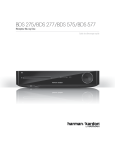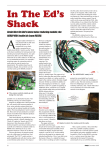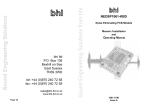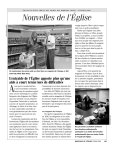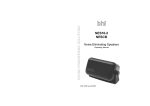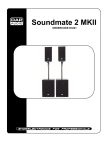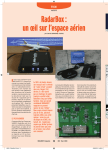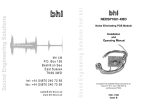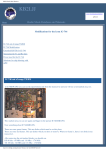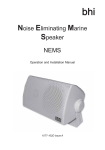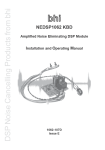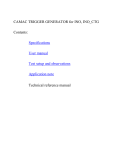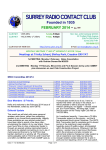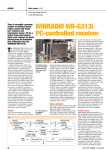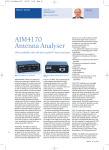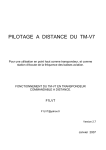Download TS440 DSP
Transcript
Translation of the article : « Comment installer un DSP dans un émetteur-récepteur non équipé ? Comment donner une seconde jeunesse à un TX d’il y a quelques années » Published by the French magazine MEGAHERTZ Issue n° 271, octobre 2005, pp 34-39 http://www.megahertz-magazine.com/ How to install the bhi DSP Noise Cancelling Module into a non-DSP transceiver or receiver. How to give a new life to an old Transceiver Jean-Paul YONNET / F1LVT [email protected] This article shows how it is possible to fit a DSP in a not equipped transceiver or receiver. By using a module made by the British company "bhi Ltd", we will see how the fitting can be made and how the system functions. As an example, the insertion of this module was made in Kenwood TS440, which allows testing its operation and appreciating its performances. Photo 0 How to install a DSP in a non-equipped transceiver or receiver Part 1: DSP and « bhi NEDSP1061-KBD » module Everyone cannot buy a modern transceiver, wit the latest technologies of filtering to improve the reception. The most recent add-on is the DSP (Digital Signal Processor), which constitutes a notable progress in very weak signals detection in the noise. We have begun to find these DSP on the audio frequencies, and even now on the last IF carrier because it is necessary to treat the signal as soon as possible in the reception chain. But for the older TX, is it possible to improve them by integrating a DSP inside? The answer is yes, and the result is really spectacular. We will see where to find this DSP and how to install it in a transceiver. The fitting was made in Kenwood TS 440 as an example; it can be adapted to many transceivers as well as receivers. Just a remark, to benefit of all the possibilities of the DSP, you need that the chain of reception is already well filtered, in particular by the very selective filters on the intermediate frequencies. 1 The DSP in a radio receiver In a transmitter or receiver, various methods are used to be able to make understandable the weakest possible signals in the noise. A significant step was made by the use of DSP (Digital Signal Processor) to detect the useful signals. Many recent transceivers and receivers are equipped with this technology. The DSP functions by digitalization then treatment of the signals. A DSP is built around a specialized microprocessor. Now more and more often, we find DSP on BF of the modern TX, and we begin to see DSP on the last IF. However, its remains a complex and expensive technology, reserved for top-of-the-range TX. For the non-equipped transmitters or receivers, we can find devices connected on the earphones output. These systems (MFJ, Telereader or bhi NEIM 1031 for example) can be connected on the audio output of the receiver and mainly function like adjustable filters and like noise reducer. We also begin to find loudspeakers with an integrated DSP, which notably improves the ratio signal/noise, like the NES 10-2MKII of the British company "bhi" [ R1,2 ]. The company, whose name "bhi" is written with lower-case letters, builds specialized DSP modules which can be integrated in non-equipped transceivers or receivers, like YAESU FT817 or KENWOOD TS50 [R 3, 4 ], or in the professional range of ICOM Radios. You can find information in English magazines like Practical Wireless or Short Wave Magazine. bhi also makes also a generic DSP module, called NEDSP1061-KBD, which can be integrated inside receivers [ 5 ], in the BF part before the final amplifier. It is this type of module that we will present (photo 1). Documentation is available on bhi’s website www.bhi-ltd.co.uk, but it exists only in English for the moment [ 6 ]. We can suppose that the French version will follow soon. The principal interest of this integrated module is to work on constant level, before the BF amplifier. More the signal treatment is made early in the reception chain more it is effective. The module NEDSP1061-KBD Photo 1 shows this module. It is very small; the dimensions of the main board are only 36 mm by 26 mm. The main integrated circuit is soldered under the board. The small switch/control keyboard (16mm X 10mm) has a two-colour LED and a pushbutton. Connexions are only four: BF input, BF output, a wire connected to supply, and a wire for the mass. It is necessary to fix the main board in the receiver not too far from the BF chain, and the small switch/control keyboard in an accessible place, for example near the upper case. Figure 1 presents the DSP module. The main board has the adjustment potentiometers: -- The input signal is adjusted by P2. In overload case of the DSP input, the LED near P2 light up. It will be necessary to adjust P2 to avoid this saturation. -- P1 allows the output level regulation after signal treatment by the DSP. -- The beep level, generated by the DSP at the starting phase and level modification, is adjusted by P3. As for the control board, it has a two-colour LED that is red when the DSP is not in service, and which transmits green pulses at the adjustment phases. The starting and the adjustments are made by the push-button. It is possible to obtain four levels of signal treatment, characterized by a number of beeps from 1 to 4. Level Tone reduction White noise reduction 1 2 3 4 5 dB 8 dB 21 dB 65 dB 11 dB 13 dB 20 dB 35 dB Table 1: The four levels of filter adjustment of the NEDSP1061-KBD 2 The fitting principle is shown on figure 2. It is necessary to place the DSP in BF line, where BF level is constant, i.e. before the volume potentiometer. It is necessary to remove a coupling capacitor, to catch the BF signal on preamplifier side (to be connected to the red wire "Audio In") and to send the signal after the DSP treatment towards the volume potentiometer (to be connected to the blue wire" Audio Out"). These wires are shielded; it is necessary to solder the shield onto a point of mass close to the capacitor which was removed. It is also necessary to connect the supply. The DSP module can be supplied between 5V and 15V, and its consumption is about 45 mA. As for the maximum audio level, it must be about 300 mV RMS on the input level of the DSP ("Audio In"). Where to find this module DSP module? The company "bhi" sells its products by a network of distributors. Ordering the module NEDSP1061KBD on the website is only possible for the countries where no distributor exists. In France, the distribution is by company GES, well known of the French ham radio. GES holds especially in stock the module adapted to Yaesu Ft-817. The electronic part of the module for the FT817 is identical to the generic module; the difference is only in the fitting and the support or fixing. Anyway for the fixing support, it will be necessary to make one adapted to your TX or your receiver. The fitting in a receiver In this article, we will describe the fitting of this "bhi" module in a transmitter Kenwood TS-440. It is only an example because the module can be fitted in very many receivers or transmitters. The results are really spectacular. The very weak signals in the noise become clearly audible. When you install this type of device in a receiver, the improvement is so impressive that you cannot use your TX more without it. Photo 1: DSP module NEDSP1061-KBD from "bhi". The central part is connected to small command board, with a pushbutton and a LED. Connections are done by: - input-output BF cable (grey cable) - Wire connected to the supply (red wire connected to a point, for a supply between 5 and 15 V), - Mass wire, to fix on a screw. 3 Figure 1: Module NEDSP1061 (Doc. "bhi"). On this drawing the two boards of the module are represented. On the main board, you can see the 3 potentiometers of adjustment, P2 for the input level, P1 for that of output and P3 for the beep level, as well as the LED which indicates the overload. On the command board, the two-colour LED which indicate the state of the DSP and the push-button for the operation control can be seen. Figure 2: Fitting of the NEDSP1061 module (Doc. "bhi"). You must insert the module at the place of the last coupling condenser before the volume potentiometer. Part 2: Fitting in a TS440 and DSP operation The fitting of the DSP module is relatively easy when you know where and how to insert it. In the TS440, the module was fixed under the upper case, near the ventilation holes, above the rear part of the IF board. This place is near the capacitor to be removed, as well as a point with "+8V" for the supply. As for the piloting of the module, we have used the key "Voice", so that no drilling is necessary in the TX case. First of all, it should be noted that the DSP will be more efficient if the receiver is correctly filtered, i.e. will be equipped with sufficiently narrow filters. For example for the TS440, it is preferable that it is equipped with the adapted quartz filters at 8,83 MHz. Figure 3 shows the TS440 "IF Unit" schematic, more precisely the BF part [ 7 ]. The BF signals come from the Q12 preamplifier, and then go to the volume potentiometer connected to the connector J2, they are then amplified by IC7. The coupling capacitor between the BF preamplifier and the potentiometer is C69, which is a polarized electrochemical condenser of 0,1 µF. It is this capacitor which must be removed to insert the DSP. 4 The component location on the TX board is presented on figure 4. The C69 capacitor is located between the 2 transistors Q12 and Q13. The signal arrives on the pin "+" of the capacitor (to be connected to "Audio In" - red wire) and goes out near the Q13 side (to be connected to "Audio Out" blue wire). The other located points are the connections of mass (in top, on the right photograph), and the "+8V" on the J3 connector. On photo 2, you can see the part of the IF board corresponding to figure 4, seen from the lateral side. The C69 capacitor is situated near the board edge, with its clear part indicating his negative pin. It is this capacitor that you must remove. Figure 3: Part of the diagram of the TS440 "IF Unit" board, showing the BF chain. When you follow the BF signals, you go successively by: -- Preamplifier Q12, -- Coupling capacitor C69 to be removed for the DSP fitting, -- J2 connector of the volume potentiometer, -- IC7 BF amplifier, -- J4 loudspeaker connector. Figure 4: Component location. The C69 capacitor is located between the 2 transistors Q12 and Q13. The signal arrives on the pin "+" of the condenser (to be connected to "Audio In" red wire) and goes out near Q13 (to be connected to "Out Audio" - blue wire). The other located points are the mass connections (in top, on the right photograph), and the "+8V" on the J3 connector. 5 Photo 2: The corner of the board "IF Unit" as saw when the upper case is removed. You can see the C69 capacitor at the rear, behind C76, between the 2 connectors J2 (blue) and J6 (white), close to board edge. You can also see the J3 connector (white) with its orange wire connected to the +8V. 2-A. Fitting of the DSP module It is initially necessary to open the case of the TS440 and to locate the various elements correctly. It is also necessary to make the support bracket which will be used for fixing the module inside the transmitter (Photo 3). Fitting of the DSP module 1- Remove the upper and lower parts of the TS440 case (17 screws to be removed). The "IF Unit" board appears under the upper cap; it is articulated on its metal support. 2- Dismount the board "IF Unit" of its support (7 screws to be removed) to be able to have access to the tracks. It is not necessary to dismount the different connectors, it is enough to raise the board to be able to reach the tracks. 3- Unsolder and remove the C69 capacitor. 4- Weld in the place of C69 (always on the track side) the connection cables of the DSP module: red wire ("Audio In") on Q12 side and blue wire ("Audio Out") on Q13 side; and mass on point "GND" of the J2 connector (of blue colour). 5- Reassemble now the "IF Unit" board with the cable going up on the side of the board. 6- Connect the supply of the DSP module. - The mass of the module is connected to the mass of the TX (see Figure 4 and Photo 4), - The red wire (+) is plugged in the connector J3 (orange wire with +8V) 7- Fix by two-sided adhesive the DSP module on the support (Photo 4) 8- Test the DSP module. All must function (Photo 5). With the power on, the red LED of the command board must light. A second pressure on the pushbutton and the DSP gets on, the LED emits some green pulses then dies out, beeps are heard in the loudspeaker at the same time as the pulses. It is the moment to adjust the potentiometers P2, P1 and P3 on the board. Attention, the potentiometers do not have stop. The input level must be adjusted by P2 for the maximum of level without saturation detected by the LED near P2. In a TS440, this saturation level is not reached. The adjustment of P1, the output level, is made easily. As for P3, which controls the beeps volume, it should be adjusted to be able to correctly control the DSP by the sound. Photo 3: Manufacturing of the support to fix the DSP module. The flat part approximately measures 40 mm x 40 mm. 6 Photo 4: The support is fixed on the TX frame on a fixing point of the "IF Unit" board. The main board and the command board are fixed on the support with a two-part epoxy adhesive. The mass is screwed on a board fixation in bottom of the photo. The wire "+" is plugged in pin 2 of the connector J3 (orange wire with +8V in the white connector). Photo 5: The TS440 in modification. You can see the DSP module installed in top on the left of the "IF Unit" board, which was raised. 2-B. Use of the push-button "Voice" to control the DSP The control of the DSP module without seeing the LED control, only by the beeps, is very easy. Only by hearing, its effectiveness is such that you immediately recognize if it is on or off by the noise level, especially on the low bands. In case of doubt, making a cycle "Stop - Start" makes possible to check operation. You can also see the red LED through the ventilation holes when the system does not function. As for the DSP level, you can control it entirely by the beeps in the loudspeaker. In the left higher angle of the front of the TS440, you find the command of the option VS1 (Voice Synthesizer). If VS1 is not installed, this push-button is available to be able to control the DSP (Photo 6). In the contrary case, it remains the traditional solution, which consists in making two holes in the upper case. We will see how it is possible to command the DSP with the push-button "Voice". One of the difficulties comes from the fact that the pushbutton is not insulated but it is connected in a circuit with a diode. You should be careful for the connections. 1- Prepare connection wire. The connector with 2 pins is manufactured with a Harwin type pin header (Photo 7). The wire colour, purple and blue, was selected to conserve the colours used on the connector J54 2- Dismount the two higher screws which retain the front face and to make it rock downwards. Take away the shielding that protects the back of the "Control Unit" board. Locate the J54 connector near the setting diodes of the microprocessor. Disconnect the J54 connector from the "Control Unit" board (Photo 8). 3- Insert the two wires cable in the J54 connector (Photo 9). 7 4- Connect the cable to the DSP command board by welding the two wires on the pins of the push-button (Photo 10). Attention with the respect of wire colours because the two systems (the PB "Voice" and the PB of the command board) are polarized. The PB of the DSP functions by ground connection of a positive tension, and PB "Voice" is in series with a diode. The DSP module can now entirely be ordered by the pushbutton "Voice" on the front face of the TS440. When the TX is fully assembled, you can see the red LED through the ventilation holes. As soon as you push one second on the PB "Voice", the DSP is on. You can initially hear the operation by the beeps, then by the loudspeaker sound. Photo 6: In the left higher angle of the TS440 front, near to the PB “Power” you find the PB "Voice". If option VS1 (Voice Synthesizer) is not inside, this push-button is available to control the DSP. Photo 7: Preparation of two-wire connector between the command board of the DSP and the PB "Voice". The connector is made with from a standard Harwin style 0.1” pitch pin header. The wire colours, purple and blue, were chosen to conserve the colours used in the J54 connector, which arrives on the "Control Unit" board. Photo 8: View of the back of the TS440 front face which was rocked. The PB "Voice" is connected to the "Control Unit" board by the J54 connector, which should be dismounted. This connector is very 8 easily locatable with its two wires only (blue and purple) on a connector with 6 pins, and its proximity of the setting diodes of the TS440 microprocessor. On this photo, this connector is half raised. Photo 9: The connecting cable is plugged in the J54 connector behind the front face. This connector is not plugged any more in the "Control Unit" board; it is now connected only to the connecting cable with DSP module. Photo 10: The two other wire ends are welded in parallel with the legs of the push-button of the command board of the DSP module. Attention to strictly respecting the colours because the pushbutton functions by ground connection of a positive tension. 2-C. Use and operation of the DSP When the TX is switched on, the DSP remains in a non-service state but it sends a number of beeps corresponding to the state where it was at the time of the preceding stop. The LED lights in red under the ventilation holes of the TS440. A one second pressure on "Voice" and you hear a short beep of confirmation of order, the red LED dies out and the DSP starts to function on the level where it was previously. In one or two seconds you can hear the background noise disappear and then the correspondent can be heard clearly. The effectiveness is impressive. One second short pressure on "Voice" and the DSP stops functioning and you hear the background noise to go up immediately. If you push more longer the PB "Voice", the DSP passes sequentially by the various levels: level 1, then 2, 3, 4, then 1 and the cycle starts again. It is necessary to stop at the selected level. This level can be identified by the series of beeps heard in the loudspeaker. When the various levels are tested, you can very clearly hear the reduction of the noise according to the level of the DSP. With the use, level 1 or 2 very quickly becomes the usual level. Level 4 is to be used in the event of difficulties of reception because the voices start to be transported by bubbles in water. But even while being limited to the first 3 levels, the effectiveness is remarkable. 9 Summary To tell the truth when you have tested the effectiveness of the DSP module on the reception, you cannot hear the radio traffic without it. Even if the cost of this module is not negligible (about 140 euros all included), this cost remains very modest compared to very spectacular improvement which it brings on the receiver audio. The presented DSP was fitted in a Kenwood TS440, a powerful transmitter-receiver and rather largely widespread, but is about fifteen years. The bhi NEDSP1061-KBD DSP module brings a second youth to it, and allows it to partially catch up with technical progress, which is made regularly on the performances of newer receivers. Its complete name, which was TS440SAT, with the coupling unit integrated, should now become TS440SAT/DSP. The bhi NEDSP1061-KBD DSP module can in the same way be integrated in many other receivers or transmitters. But it is necessary to have the circuit diagrams to make the modification. References: [1]. Kevin Nice, « NEIM 1031, Noise Eliminating In Line Module », Short Wave Magazine, March 2003, pp 45-46 [2] Denis Bonomo, F6GKQ, «bhi NEIM 1031 et NES 10-2 : Eliminez le bruit», MEGAHERTZ Magazine, n°250, Jan 2004, pp 18-19 [3] Chris Lorek, G4HCL, «DSP Noise Reduction Module for Yaesu FT-817» RadCom, Dec 2003, pp 24-25. [4] Denis Bonomo, F6GKQ, «Réducteur de bruit à DSP pour FT-817, bhi NEDSP 1061», MEGAHERTZ Magazine, n°252, Mars 2004, pp 20-22. [5]. Kevin Nice, « In the Ed Shack: … the NEDSP 1061 inside ICOM R 8500 », Short Wave Magazine, Dec 2003, pp 32-33 [6]. http://www.bhinstrumentation.co.uk/html/nedsp1061_pcb.html http://www.bhinstrumentation.co.uk/html/nedsp1061-kbd.html [7].« Service Manual TS440 », documentation Kenwood 10










